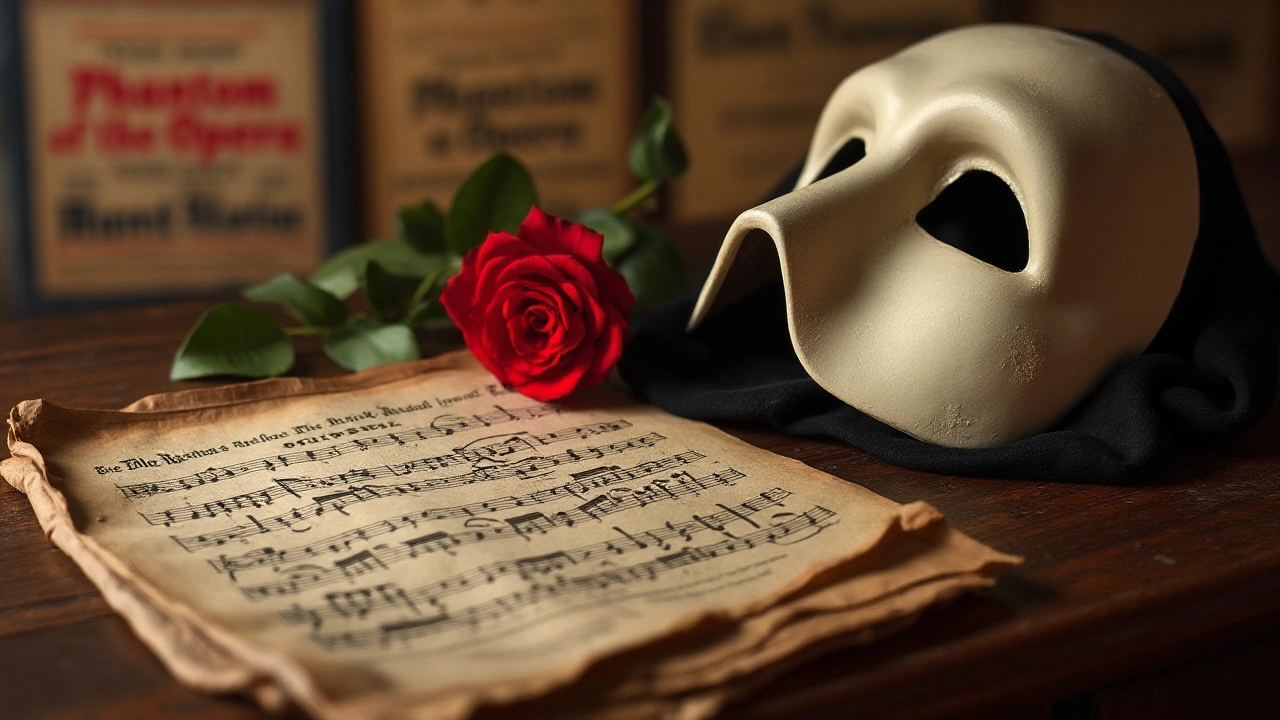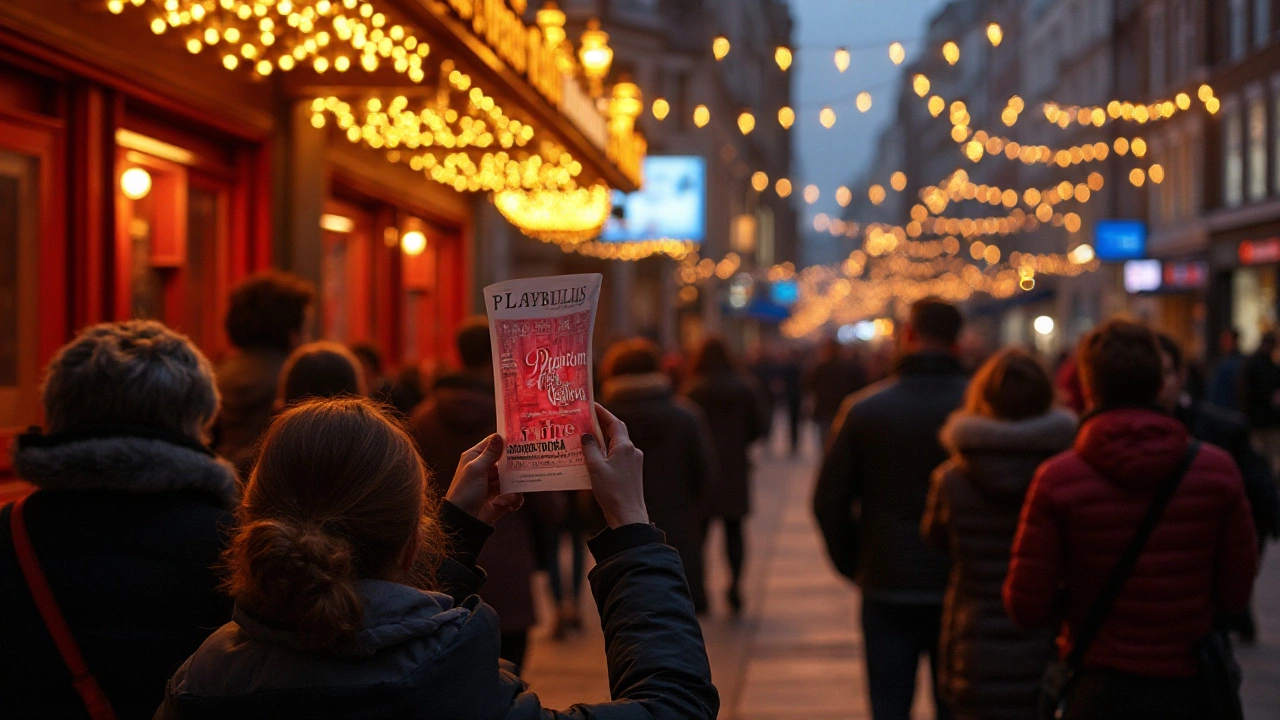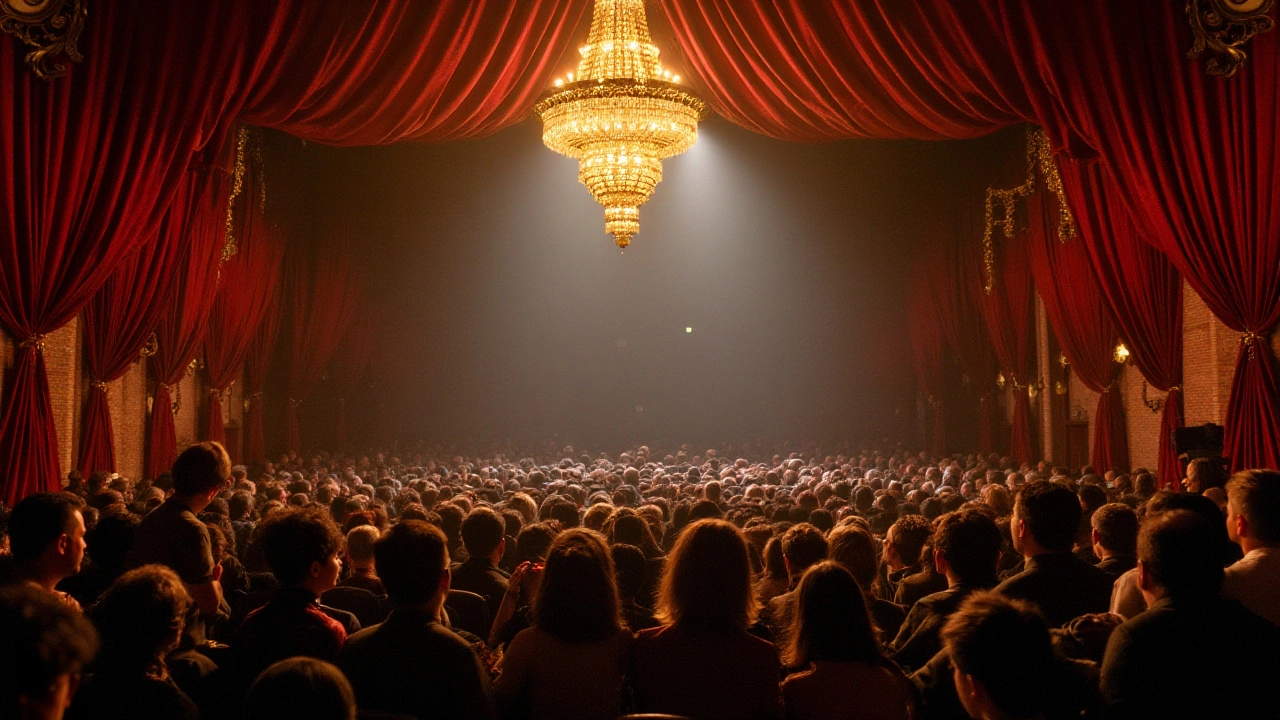'The Phantom of the Opera' closing its Broadway chapter is the end of a spectacular era. This story of love, mystery, and music captivated audiences and boasts the life's work of its composer Andrew Lloyd Webber. Known for its lavish set designs and the iconic chandelier drop, the musical redefined theatrical experience. It brought an emotional depth to the stage that made viewers see a darker world behind the mask. As the Phantom takes its final bow, aficionados reflect on its enduring legacy and the cultural shifts it inspired in musical theater.
Over time, 'The Phantom of the Opera' transcended the stage and seeped into cultural consciousness, drawing audiences again and again with its unforgettable melodies and poignant performances. For many, it opened the door to the magical world of theater. The intricate costumes, evocative music, and thrilling storyline have continuously proven to be a draw for theatergoers, making it an ageless classic. Now, as Broadway says goodbye, the question remains: what comes next for the timeless story of the Phantom? With a history that spans decades, the musical will undoubtedly remain close to the hearts of millions and serve as an inspiration for future theatrical endeavors.
- The Legacy of 'The Phantom of the Opera'
- The Journey to Broadway
- Why the Phantom Resonated
- The Impact on Theater Culture
- Memorable Productions and Casts
- What's Next After the Mask Comes Off?
The Legacy of 'The Phantom of the Opera'
'The Phantom of the Opera' isn't just a musical, it's a phenomenon that transcended the boundaries of theatrical experiences worldwide. Since its debut in London’s West End in 1986, not long before it made its way to Broadway in 1988, the musical has captured the imaginations of millions with its haunting tale of love and desire. Over its 35-year run, it clocked over 13,000 performances, making it the longest-running show in Broadway history. The musical's impact extended far beyond the stage, embedding itself in global popular culture, inspiring countless adaptations, parodies, and tribute performances. Its timeless music, composed by Andrew Lloyd Webber, including hits like "The Music of the Night" and "All I Ask of You," continues to resonate with audiences of all generations.
The musical's lush productions, with their grandiose settings, exquisite costumes, and the legendary falling chandelier, set new benchmarks for theatrical opulence and technical sophistication. Former conductor David Caddick once remarked about its irresistible allure, "Night after night, 'The Phantom of the Opera' creates magic. It's an experience beyond the music, something that envelopes you entirely."
In an interview, Webber aptly described the musical as "an exploration of the beauty and the beast within us all," a theme that helped it appeal both to heart and mind.The Phantom himself, a complex figure of mystery and tragedy, offered actors the opportunity to explore the depths of love, despair, and redemption, making it a prized role for performers across generations.
The theater wasn't the only avenue where 'The Phantom of the Opera' left its mark; it played a significant role in the evolution of marketing and merchandise in theater culture. The mask of the Phantom became an icon, adorning everything from posters and apparel to home décor items. Whether it's through stirring renditions in amateur theater or international productions, the influence of the Phantom remains vivid. It often benefited charitable organizations, with gala performances that have raised substantial funds, ensuring the show’s spirit of giving back.
As the curtain closes on Broadway, this doesn't mark the end for 'The Phantom.' Touring productions around the globe continue to breathe life into its legacy, ensuring the Phantom’s serenades from the depths of his lair will echo for years to come. While new shows will rise and fall in the ever-evolving musical landscape, the imprint of ‘The Phantom of the Opera’ on Broadway is indelible, marking a pinnacle of creative and commercial achievement that few productions can hope to match. Its capacity to touch hearts and evoke emotion reminds us all why we turn to the arts: to feel, to dream, and most importantly, to connect.
The Journey to Broadway
The glittering journey of 'The Phantom of the Opera' to Broadway is one adorned with passion, ambition, and a little melodrama that mirrors its plot. It all began in the 1980s, a time when Andrew Lloyd Webber was already making waves in the theater world with hits like 'Cats' and 'Starlight Express'. Inspired by Gaston Leroux's novel, Webber started crafting a musical that would intertwine his love for hauntingly dramatic music and poignant storytelling. His collaboration with lyricist Charles Hart led to the birth of melodies that would one day resonate in the hearts of millions, turning the Phantom’s tale into a monumental success.
Debuting originally in London’s West End in 1986, the production was met with immediate acclaim. Bringing it to Broadway was inevitable. On January 26, 1988, at the Majestic Theatre, the New York version of 'Phantom' unfurled its curtains to an audience ready for enchantment. It wasn't just Andrew Lloyd Webber’s name behind the attraction; it was the grand production value that included a striking chandelier and lavish set designs by Maria Björnson. Directed by Harold Prince, the spectacle was further elevated by its cast, led by Michael Crawford and Sarah Brightman, who brought the Phantom and Christine Daaé to life.
The Broadway stage embraced 'Phantom' with the grandeur it deserved, recognizing it not only for its musical genius but also for its technological advancements. The elaborate set pieces and effects, pivotal to its plot and aesthetic, were groundbreaking at the time. Costing about $8 million to produce, the stakes were unusually high, yet the risk paid off. The musical captured the audience’s fascination and quickly became a staple, ushering in a new era of opulence and ambition on the Great White Way. By the end of its first year on Broadway, it had grossed over $1 million, signaling not just a financial triumph but a new chapter in theater history.
Sir Andrew Lloyd Webber once said, “The theater is a living art form; it struggles with reality but in doing so lays bare more truth than any mirror could reflect.” This statement, made during the show's 10th anniversary, encapsulates how 'Phantom’ bridged fantasy with poignant truths about love and acceptance, resonating deeper with audiences every passing year.

Why the Phantom Resonated
When 'The Phantom of the Opera' first graced Broadway stages, it wasn't just the grandeur that drew people in. The musical tapped into universal themes; love, obsession, and the haunting pull of unrequited passion, which struck a chord with anyone who's ever felt deeply. Andrew Lloyd Webber's soaring compositions created an immersive soundscape that both intoxicated and thrilled audiences, unlike any musical before. The intensity of 'Music of the Night' and the haunting silence of 'The Point of No Return' left these songs echoing long after the curtains fell.
Moreover, the enigmatic allure of the masked phantom himself is central to the musical's long-lasting appeal. He is a tormented maestro, shrouded in mystery, driven by his fierce genius and his tragic past. Many found his struggle deeply relatable, a poignant reflection of the human condition—isolated and yearning for acceptance. A misfit, yet wildly talented, the Phantom becomes a symbol of the beauty underneath, a figure who captured imaginations and spurred empathy. As famous theater critic, Ben Brantley, once remarked,
"The phantom is more than just a character; he's a mirror to our innermost fears and desires, leaving us both enthralled and introspective."
The visual splendor also added to the magnetic pull of the production. From the moment the extravagant chandelier spiraled towards the audience to the lavish costumes and gothic architecture, Broadway attendees were whisked away into a world both surreal and captivating. Many regulars found themselves returning multiple times merely to relive the lush and intricate spectacle. Not just a feast for the ears, but a grand visual tale that appealed to both young and old alike.
But beyond its surface beauty, 'The Phantom of the Opera' offered a narrative complexity rare in musical theater, challenging viewers to grapple with conflicting emotions. A tale of morality wrapped in compelling visuals, the musical posited questions about the nature of love and the cost of one's ambitions. As audiences delved deeper, many recognized the echoes of Gothic lore — where shadows hold truths and faces conceal hidden dreams. These multi-layered dimensions made the phantom's world endlessly intriguing, ensuring it resonated for decades. Such was the impact of the show's themes that various adaptations across the globe sprung up, each striving to capture the same evocative magic that Andrew Lloyd Webber originally envisioned.
The Impact on Theater Culture
'The Phantom of the Opera' has not just been a mere spectacle on Broadway; it has profoundly reshaped the landscape of theater itself. Since its debut, the musical has become a benchmark for theatrical production quality and storytelling depth, elevating standards and expectations. At its core, the show's unique blend of haunting music, compelling characters, and stunning visual effects has set a new bar for sensory experiences in theater. Its success demonstrated that audiences were hungry for elaborate storytelling with emotional resonance and daring creativity. It catalyzed a trend where other productions began to invest in not only storytelling but also in the grandeur and technical aspects to immerse the audience completely, making theater a vibrant journey rather than just a spectacle.
The cultural footprint of the Phantom is extensive, influencing countless productions that followed. From the intricate costumes to the iconic musical numbers, every aspect of the show served as an inspiration and a challenge for other creators in the industry to push their boundaries. For an entire generation of theater lovers, the Phantom became synonymous with epic, engaging stories; its influence resonated beyond just musical arrangements, as it nurtured a deeper appreciation for artistry and craftsmanship among theatergoers and creators alike. The magic of live performance was rejuvenated, attracting not just local enthusiasts but also international tourists who sought to experience the monumental production firsthand. Many performances today still evoke elements of what made 'The Phantom of the Opera' a cultural icon, including its commitment to emotive storytelling and spectacle.
"The Phantom of the Opera is not merely a stage show; it's a cultural phenomenon," said a leading critic in the early 2000s. "It changed how we perceive the dreamy mix of fantasy and tragedy in theatrical storytelling."
From Andrew Lloyd Webber's extraordinary score to the elaborate staging and lighting, the musical impressed upon productions worldwide that the devil was indeed in the details. Its wide-reaching influence eclipsed the boundaries of mere performance art, affecting the themes and expectations with which audiences approached theater. Encouraging complex narratives and intricate staging, it pioneered a new era that invited fresh ideas while continuing to honor the traditional roots of musical theater. Moreover, it contributed significantly to Broadway's economics, drawing consistent crowds over its 35-year tenure. The musical's success encouraged other grand-scale productions to take risks and explore different narratives, topics, and styles, forever changing what people expect when they step into a theater. As we bid farewell to this legendary show, its influence is unmistakable, ensuring the spirit of bold theatrical innovation and storytelling will carry on.

Memorable Productions and Casts
The legacy of The Phantom of the Opera on Broadway is a tapestry woven with unforgettable performances and captivating productions. Among these, the original cast from 1988 holds a special place in the annals of theater history, featuring the unsurpassed talents of Michael Crawford and Sarah Brightman. Crawford's rich baritone and nuanced portrayal of the tortured genius of the Phantom captivated audiences, earning him a Tony Award for Best Actor in a Musical. Brightman, whose ethereal soprano as Christine Daaé left theatergoers spellbound, shared a unique chemistry with Crawford, making their performances both poignant and electrifying.
Ever since the musical raised its curtain at the Majestic Theatre, each subsequent cast has managed to honor this standard of excellence while injecting their unique touch into the legendary roles. Various actors over the years have donned the famous mask, bringing new dimensions to the Phantom. Notable among them is Norm Lewis, who broke ground as the first African American to play the Phantom on Broadway, enriching the role with his powerful voice and intense emotional depth. Sierra Boggess, celebrated for her compelling interpretation of Christine, brought a fresh grace and strength to the performance, echoing Brightman's legacy while stepping beautifully into her own artistry.
Across various international productions, the musical's adaptability shines with numerous talented ensembles who have carried its essence far and wide. From the glitz of Las Vegas to the historic stages of London's West End, each adaptation involves an interplay of local cultural influences that breathe new life into the show. The careful attention to details in set design and costumes, with the legendary chandelier crash and the enigmatic underground lair, consistently wowed audiences and set a high bar for theatrical aesthetics. The Phantom’s haunting melodies continue to draw in new generations, cementing its status not only as a staple of Broadway but as a global phenomena echoing in theaters from Tokyo to Melbourne.
To put this journey into perspective, theater critic Ben Brantley once opined,
"The Phantom’s multiple interpretations over the decades testify to the boundless capacity of Andrew Lloyd Webber's creation to transform and renew, even as audiences worldwide continue to embrace its grandeur."His insights reflect the enduring allure of the story, the score, and those who breathe life into them year after year. Even as the curtain closes on its Broadway run, the spirit of The Phantom of the Opera will undoubtedly continue to soar in hearts and theaters globally, inspiring future artists to pick up the mask and let the music ignite new imaginations.
What’s Next After the Mask Comes Off?
As Phantom of the Opera steps away from the bright lights of Broadway, its final curtain symbolically marks a transition, both for the fans and for the world of musical theater. The story of the Phantom has always been one of timeless enchantment—a deep dive into the world of romance and the supernatural. Its departure leaves a void, prompting enthusiasts and creators alike to wonder what can fill the shoes of a musical that has set the gold standard for theatrical production.
With the Broadway musical off the roster, several opportunities emerge. The theatrical community has always thrived on innovation, and this shift provides an open stage for fresh narratives, new voices, and novel styles. Much like when 'Phantom' revolutionized the scene with its grand theatricality and the haunting power of the score by Andrew Lloyd Webber, future productions could leverage contemporary themes that resonate more profoundly with today's audiences. This shift might include stories that highlight inclusivity and diversity, drawing from a global palette of culture and experience.
‘Musicals must evolve with changing times, embracing stories that push boundaries just as ‘Phantom’ did with its original narrative,’ notes theater historian Douglas Muzio during a recent panel discussion on the future of Broadway.
Interestingly, as the traditional stage showcases fewer spectacular marvels like 'Phantom,' the world of digital adaptations may well take the baton forward. Technologies such as virtual reality could offer audiences an immersive experience, simulating the grandeur of Broadway productions from home. Further, online streaming platforms, already famed for bringing musicals like 'Hamilton' to the masses, are poised to explore and expand on this legacy. A musical of such caliber moving online or into hybrid formats will continue to captivate new generations who consume media in diverse ways.
Even though we bid adieu to the live stage performance on Broadway for 'Phantom,' the franchise is far from closing its book. Tours continue globally, introducing the enigma to locales that may not have had the chance to visit New York’s theater district. Meanwhile, educational institutions and community theaters maintain the spirit of 'Phantom' alive, offering adaptations that reinvigorate interest in local communities and aspiring young actors. These efforts ensure that Andrew Lloyd Webber's masterpiece resonates with audiences worldwide, long after the original masks are set aside.
The question of 'What next?' can often be daunting, but it is precisely this uncertainty that sparks creativity. Just as 'Phantom' once emerged and dazzled, transforming expectations and redefining standards, its departure may inspire a wave of creativity, birthing the next iconic production to take Broadway—and the world—by storm.
In closing, what lies next is limited only by the imagination of those who dare to dream like the Phantom, lurking in the shadows until the moment is ripe for the light. The leaving of one legendary curtain is merely the opening of a new one, ready to rise over the innovative specters of the future in musical theater.

